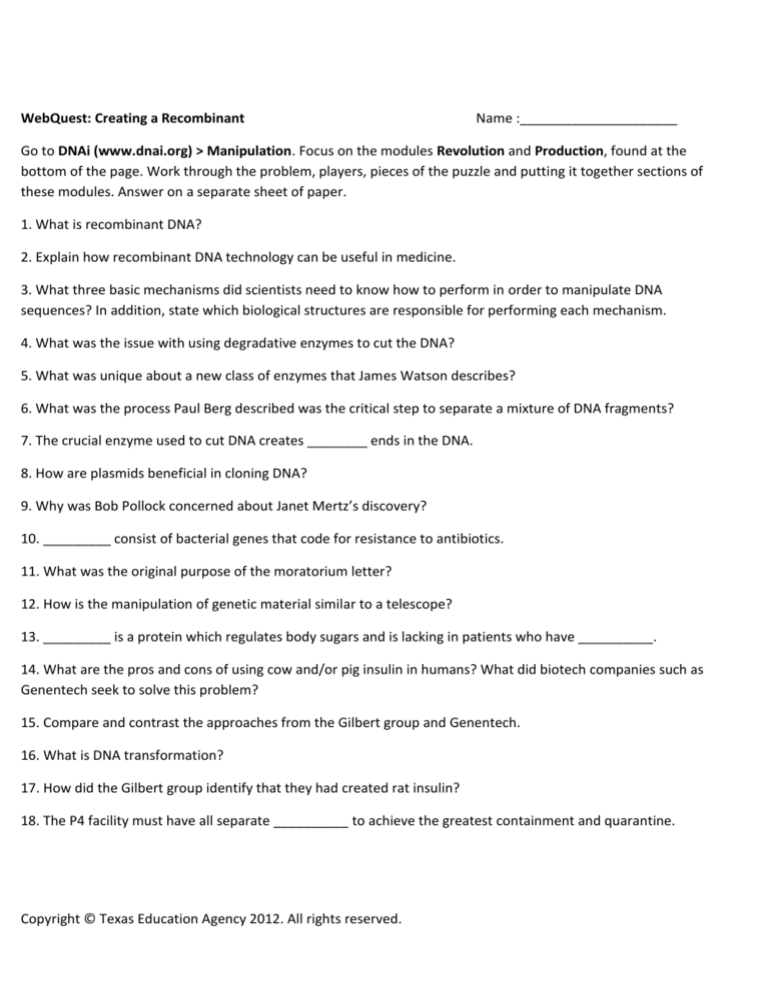
WebQuest: Creating a Recombinant
Name :_____________________
Go to DNAi (www.dnai.org) > Manipulation. Focus on the modules Revolution and Production, found at the
bottom of the page. Work through the problem, players, pieces of the puzzle and putting it together sections of
these modules. Answer on a separate sheet of paper.
1. What is recombinant DNA?
2. Explain how recombinant DNA technology can be useful in medicine.
3. What three basic mechanisms did scientists need to know how to perform in order to manipulate DNA
sequences? In addition, state which biological structures are responsible for performing each mechanism.
4. What was the issue with using degradative enzymes to cut the DNA?
5. What was unique about a new class of enzymes that James Watson describes?
6. What was the process Paul Berg described was the critical step to separate a mixture of DNA fragments?
7. The crucial enzyme used to cut DNA creates ________ ends in the DNA.
8. How are plasmids beneficial in cloning DNA?
9. Why was Bob Pollock concerned about Janet Mertz’s discovery?
10. _________ consist of bacterial genes that code for resistance to antibiotics.
11. What was the original purpose of the moratorium letter?
12. How is the manipulation of genetic material similar to a telescope?
13. _________ is a protein which regulates body sugars and is lacking in patients who have __________.
14. What are the pros and cons of using cow and/or pig insulin in humans? What did biotech companies such as
Genentech seek to solve this problem?
15. Compare and contrast the approaches from the Gilbert group and Genentech.
16. What is DNA transformation?
17. How did the Gilbert group identify that they had created rat insulin?
18. The P4 facility must have all separate __________ to achieve the greatest containment and quarantine.
Copyright © Texas Education Agency 2012. All rights reserved.
WebQuest: Biotech Techniques
Name :______________________
Go to DNAi (www.dnai.org) > Manipulation. Focus on the module Techniques. Work through cutting & pasting,
transferring & storing, etc. at the top of the page.
1. ____________ ____________ are used to cut DNA at specific sequences while _________ _________ is used to
“paste” DNA by joining complementary ends of DNA fragments.
2. What does it mean for the ends of a foreign DNA fragment to be complementary to the ends of a cut plasmid?
3. What are the steps that must occur for a plasmid to be considered a “recombinant” plasmid?
4. Why did the plasmid solve the problem that Herbert Boyer’s definition of restriction caused for transferring
DNA from one organism to another?
5. Why can’t small loops of DNA naturally enter the adhesion zones of bacteria when size is not a factor?
6. How does the calcium chloride method solve the problem mentioned in the previous question? How does
temperature change complement the use of calcium chloride?
7. __________ became the workhorses of the public Human Genome Project.
8. Name the five different vectors that are used as “DNA libraries” and arrange them by the amount of inserted
DNA base pairs they can carry from smallest to largest.
9. ___________________ is a type of bacteria that has natural genetic engineering capabilities and is found in
_______ almost everywhere in the world.
10. Robert Horsch describes how Agrobacterium tumefaciens transfers a segment of DNA with genes that do two
things. What are these two things and why are they important for the life of the bacteria?
11. A _______ ______ was the major alternative to the use of agrobacterium for transferring DNA to living plant
cells.
12. DNA sequences are built up on GeneChips® through the addition of nucleotides to specific sites on the chip. A
_______ is used so that only some specific sites are exposed to ____ light. This type of light frees the nucleotide
from the protecting group so that an additional nucleotide maybe added to the sequence. When a ________
probe is added to the GeneChip®, tens of thousands of different sequences can be screened at the same time. The
DNA sequences that match the specific probe can be matched with available DNA sequences in gene
____________.
13. DNA arrays allowed Pat Brown to perform large-scale ______________ studies, which proved helpful in
identifying two subtypes of diffuse large B-cell lymphoma (DLBCL).
14. ___________________ is a type of tailored treatment for patients who were diagnosed with the help of DNA
arrays.
15. _____ _________________ is the process used to separate DNA fragments by size and a _____ is used to
visually track DNA migration during this process.
16. Referring to the process mentioned above, explain what causes DNA fragments to migrate in a certain
direction and why size matters in the migration of DNA fragments.
17. Why did the addition of a dideoxynucleotide (didNTP) halt elongation of a DNA fragment for the DNA
sequencing method created by Fred Sanger?
18. During electrophoresis, DNA fragments of the ___________ size will migrate to the same place and “band” in
the gel.
19. Name the four basic components that you need to sequence DNA and describe how temperature is used to
manipulate these components for DNA sequencing.
20. ________________ _____________ _____________ allows researchers to bypass the need to use bacteria for
amplifying DNA.
21. ____ cycles of PCR are needed to begin making target copies, or DNA fragments of the desired length.
22. In PCR, the primers are designed to bracket the DNA region to be amplified. What does this mean?
23. What are model organisms and how does evolution explain why model organisms are useful in understanding
the human body?
24. Why would the sea squirt be a potential model organism?







